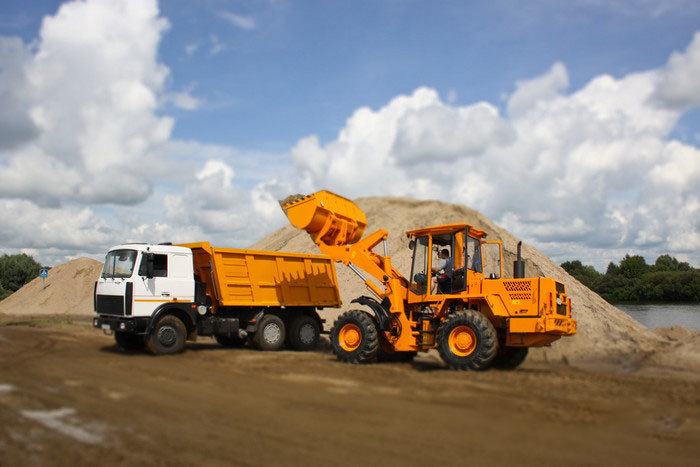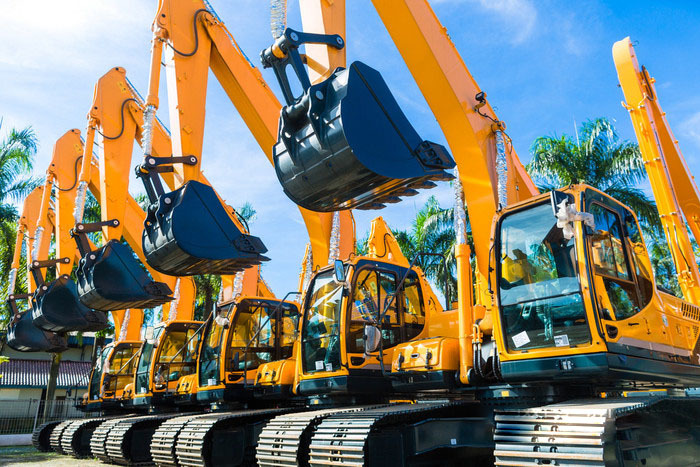How to deal with excavator accidents and its safe operation
Release Time:
Jun 30,2021
When the hydraulic excavator is working normally,the hydraulic oil temperature should be between 50 degrees and 80 degrees.Before the machine is used,if it is lower than 20 degrees,it should be preheated;when it reaches or exceeds 80 degrees,it should be shut down to dissipate heat.

Safe operation of excavators
1.Preparation before homework:
1.Carefully read the relevant instruction materials of the excavator,and be familiar with the use and maintenance of the vehicle you are driving;
2.Understand the tasks of the construction site in detail,and check the firmness and stability of the soil where the excavator stops.When excavating foundation pits and trenches,check the stability of cuttings and trench slopes;
3.It is strictly forbidden for any personnel to stay in the work area,and the work site should be convenient for dump trucks to enter and exit;
4.Check the hydraulic system of the excavator,engine,transmission,braking device,slewing device,and instruments and meters.It can only work after it has been tested and confirmed to be normal.
2.Requirements during operation and driving:
1.A signal should be sent before the operation starts;
2.When operating,pay attention to selecting and creating a reasonable working surface,and it is strictly forbidden to dig holes;it is strictly forbidden to arrange the excavator in two digging surfaces to operate at the same time;it is strictly forbidden to work under high-altitude erections such as electric wires;
3.During operation,it is forbidden to adjust the engine,governor,hydraulic system,and electrical system casually;it is forbidden to use bucket to break or use rotary machinery to break solid objects;it is forbidden to use bucket rod or bucket cylinder to jack up the excavator;forbidden Use the excavating arm to drag the heavy objects on the side;it is forbidden to excavate by the sudden drop of the working device;
4.The excavator should be loaded after the car has stopped.When unloading,the bucket should be lowered as far as possible without touching any part of the car,and the bucket should not be allowed to pass over the cab;
5.When the hydraulic excavator is working normally,the hydraulic oil temperature should be between 50 degrees and 80 degrees.Before the machine is used,if it is lower than 20 degrees,it should be preheated;when it reaches or exceeds 80 degrees,it should be shut down to dissipate heat.
3.Post-work requirements:
1.When the excavator is walking,it should be directed by a special person,and the distance from the high-voltage line should not be less than 5 meters.It is forbidden to walk backwards;
2.When walking downhill,you should drive at a low speed and at a constant speed,and it is forbidden to slide and change speed;
3.The parking position and walking route of the excavator should be kept a safe distance from the road,ditches,and foundation pits;
4.When the excavator is parked on a slope,the bucket must be placed on the ground,and all operating levers should be placed in the middle position;
5.After the work is over,the fuselage should be turned upright,the bucket should be placed on the ground,and all operating levers should be placed in the neutral position.The brakes of all parts are applied,and the driver can leave after closing the mechanical doors and windows.
Click to collapse
Safe operation of excavators
Excavator maintenance
1.Avoid only adding but not changing the oil
Engine oil is indispensable in the use of diesel engines,mainly for lubrication,cooling and cleaning.Therefore,many drivers pay attention to checking the amount of lubricating oil and adding it according to the standard,but they neglect the inspection of lubricating oil quality and the replacement of deteriorating oil,resulting in some engine moving parts always in poor lubrication Operation in the environment,thereby accelerating the wear and tear of various parts.Under normal circumstances,the loss of engine oil is not large,but it is easy to pollute,thus losing the role of protecting the diesel engine.During the operation of the diesel engine,a lot of dirt(soot,carbon deposits and fouling,etc.,produced by incomplete fuel combustion)will enter the engine oil.For new or overhauled machinery,there will be more impurities after trial operation.If you just add it and not change it,you will be eager to put it into use,which will easily cause accidents such as tile burning and shaft holding.In addition,even if the engine oil is changed,some drivers will not thoroughly clean the oil passage due to lack of maintenance experience or save trouble,so that mechanical impurities still remain in the oil pan and oil passage.
2.Avoid using butter indiscriminately
(1)Grease the cylinder head gasket.Butter is a commonly used grease in the repair of construction machinery,which can play a role of lubrication and sealing.Therefore,some repairers will put a layer of butter on the cylinder head gasket when installing the cylinder head gasket,believing that this can increase the sealing performance of the diesel engine.As everyone knows,doing so will affect the working performance of the diesel engine.Cylinder head gasket is the most important seal between the cylinder block and cylinder head of a diesel engine.It can not only seal the high temperature and high pressure gas generated in the cylinder,but also seal the cooling water and lubricating oil in the cylinder head and cylinder block.When disassembling the cylinder head gasket,pay special attention to its sealing quality.If grease is applied to the cylinder head gasket during installation,when the cylinder head bolts are tightened,part of the butter will be squeezed into the cylinder water passage and oil passage.When the butter between the cylinder head gasket is working in the cylinder,part of it will flow due to the influence of high temperature.The human cylinder burns,and the other part remains on the joint surface of the cylinder block and cylinder head,causing gaps between the cylinder head gasket,cylinder head,and the plane of the block.High-temperature and high-pressure gas can easily hit the cylinder head gasket from here,destroying the cylinder head gasket and causing leakage.gas.In addition,if the butter is exposed to high temperature for a long time,it will produce carbon deposits,which will cause premature aging and deterioration of the cylinder head gasket.Therefore,do not apply butter when installing the cylinder head gasket.
(2)Grease the tire nuts.In order to easily tighten the nuts and prevent corrosion,many repairers apply oil to the bolts and nuts of the tires.In fact,this is a wrong approach.Because after the tire nut is tightened,there is a self-locking feature between the threads.This is because the thread helix angle is smaller than the equivalent friction angle between threads.In a given bolt connection,the helix angle is a certain value,and the equivalent friction angle changes with the friction state between the threads.Obviously,the equivalent friction angle between the threads is reduced after oiling,and the self-locking performance of the bolt connection becomes worse.Therefore,never apply grease or drip lubricating oil on the bolts and nuts of the tire.Doing so will loosen the nuts and even cause accidents.
3.Avoid installing new cylinder liners and pistons without matching
When replacing the cylinder liner and piston,it is considered that the new cylinder liner and piston are standard parts,and they are interchangeable,and can be used after they are installed.In fact,the size of cylinder liner and piston has a certain tolerance range.If the largest size cylinder liner is fitted with the smallest size piston,the clearance will be too large,resulting in weak compression and difficulty in starting.Therefore,the size grouping code of the standard cylinder liner and piston must be checked when reinstalling.The installed cylinder liner and piston must make the size grouping code of the standard piston and the standard cylinder liner the same.Only in this way can the difference between the two be guaranteed.Has a standard fit clearance.In addition,when each cylinder is installed with liners and pistons of the same group code,attention should be paid to the inspection of the cylinder plug gap before installation.In order to ensure the assembly standard,a test should be carried out before installation to prevent counterfeit and inferior products from being installed..
4.Avoid not checking the plunger stroke margin
In the ironic test of the plunger fuel injection pump,many maintenance personnel did not pay attention to checking the stroke margin of the plunger.The so-called stroke margin of the plunger refers to the amount of movement that the plunger can continue to move upward after being pushed to the top dead center by the cam on the camshaft.After adjusting the fuel supply start time,the reason why the stroke margin is checked is because the stroke margin of the plunger is related to the wear of the plunger and sleeve.After the plunger and the sleeve are worn,the plunger has to move up for a while to start the oil supply,which delays the start of the oil supply.When the adjusting bolt is unscrewed or a thicker adjusting pad or gasket is used,the lowest position of the plunger moves up,so that the stroke margin of the plunger is reduced.Therefore,when repairing and debugging the fuel injection pump,the stroke margin should be checked first to determine whether the fuel injection pump is still allowed to be adjusted.During the inspection,the following different methods should be adopted according to the different structure of the fuel injection pump:a)Rotate the camshaft,push the plunger to the top dead center,remove the delivery valve and valve seat,and measure with a depth vernier.b)After the plunger is pushed to the top dead center,use a screwdriver to pry the spring seat of the plunger spring to raise the plunger to the highest point.Then insert a thickness gauge between the lower plane of the plunger and the tappet adjustment bolt to measure.The standard stroke margin of the plunger is about 1.5mm,and the limit stroke margin after wear should not be less than 0.5mm.
5.Avoid inaccurate cylinder clearance measurement
When measuring the cylinder clearance,it failed to measure in the direction of the piston skirt perpendicular to the piston pin hole,and measured in other directions.The structure of the aluminum alloy piston is characterized by a small upper part and a larger lower part.It is a cone,and the skirt section is elliptical,so the cylinder clearance along the circumferential direction is not equal.When measuring,it is stipulated that the clearance in the direction of the long axis of the ellipse shall prevail,that is,the clearance of the piston skirt perpendicular to the direction of the piston pin hole is measured.This measurement is more convenient and accurate,and in reciprocating motion,the direction of the piston skirt perpendicular to the piston pin hole is greatly worn due to the side pressure.Therefore,when measuring the cylinder gap,the piston skirt should be perpendicular to the piston.The direction of the pin hole is measured.
6,avoid piston open flame heating
Since the piston and the piston pin have an interference fit,when installing the piston pin,the piston should be heated and expanded.At this time,some maintenance personnel will directly heat the piston on an open flame.This approach is very wrong,because If the thickness of each part of the piston is uneven,the degree of thermal expansion and contraction will be different.Open flame heating will cause uneven heating of the piston,which is easy to cause deformation;the surface of the piston will also adhere to charcoal,which reduces the service life of the piston.If the piston cools naturally after reaching a certain temperature,its metallographic structure will be damaged and the wear resistance will be greatly reduced,and its service life will be significantly shortened.When installing the piston pin,the piston can be evenly heated in hot oil to make it expand slowly.Do not use an open flame to heat it directly.
7.Avoid using emery cloth to polish the bearing bush
For some inexperienced repairers,scraping the bush is a difficult task.Because the scraping technology is difficult to master,it is difficult for the bush to meet the technical requirements.For this reason,when someone replaces the bush,it is necessary to increase the size of the bush and The contact area ofthe crankshaft is polished with emery cloth instead of scraping tiles.This method is extremely undesirable in actual maintenance,because the abrasive grains on the emery cloth are harder,while the bearing alloy is softer,so the sand grains are easily embedded in the alloy during grinding,and the wear of the journal will be accelerated when the diesel engine is working.Shorten the life of the crankshaft.
8.Avoid tightening the bolts too tightly
In the process of disassembly and assembly of construction machinery,bolts in many parts have specified torque requirements,such as transmission box,cylinder head,wheel hub,connecting rod and front axle.The tightening torque is specified in the manual.Feel free to change.However,many users mistakenly believe that tightening is safer,but tightening too tight will cause the screw or bolt to break,and may also cause failure due to the threaded sliding button.
9.Avoid high tire pressure
The tire inflation pressure of wheeled construction machinery is an important factor that determines its service life and work efficiency.Tyre pressure that is too high or too low will affect its service life,and it is also not conducive to safe driving,especially in the hot summer.The scientific inflation standard should be based on the standard air pressure of the tire,and with the change of temperature,it is only right to slightly adjust the tire air pressure.For example,summer should be 5%-7%lower than winter.Taking into account that the temperature in summer is high,the gas is heated and the pressure increases.On the contrary,it must reach the standard pressure or slightly lower in winter.
10.Avoid adding cold water to the water tank suddenly
Overloading of the engine,poor heat dissipation,or lack of water in the water tank will cause the water tank to boil.If cold water is immediately added at this time,it will cause the cylinder head and cylinder block to burst.Therefore,once the water tank is found to be boiling during use,emergency measures should be taken to stop the operation so that the diesel engine cooling water can cool down by itself.
Click to collapse
Excavator maintenance
Excavator troubleshooting
1.Reasons for"jumping"
(1)Wear and tear of the variable speed transmission mechanism W4-60 excavator adopts a mechanical shift transmission mechanism.This transmission mechanism relies on the sliding gear sleeve to move axially on the fixed gear sleeve and interact with the driven gears of each gear.Engaged to achieve shifting.In the frequent shifting process,the tooth end faces of the aforementioned meshing gears are easily ground into a cone shape,which reduces their meshing performance and causes"shifts".
(2)The performance of the self-locking mechanism is reduced to prevent the transmission"jumping".This type of excavator is in the box cover hole above the shift fork shaft of the gearsⅡ,Ⅲand gearsⅣandⅤand in the shift forks of theⅠand reverse gears.Both are equipped with steel balls and springs that play a self-locking role.When the elasticity of the spring for positioning and self-locking is weakened or broken,the self-locking performance of the self-locking mechanism will decrease or disappear,causing the transmission to"jump".At the same time,if the positioning steel ball or the groove on the fork shaft is worn out,it can also cause the transmission to"jump".
(3)Improper adjustment of the shifting device The transmission of this type of excavator uses mechanical manual shifting.If the shift lever,vertical shaft,horizontal shaft and vertical fixing screws are loose,the transmission may"jump".
(4)Sudden change of external load Due to the nature of the excavator and the design of the machine itself,the sudden change of external load will also cause its transmission to"jump".When the road surface is uneven,the machine is driving downhill or the driving route is improper and the external load suddenly changes,this sudden change of load will act on the gear meshing gears of the transmission through the wheels and drive shafts,causing the gears to mesh with the gears.Disengagement due to the generation of axial thrust,causing the transmission to"jump".
(5)Improper operation method When the excavator is driving on a slope(especially driving downhill),if the operation is improper,it will also cause the transmission to"jump".
2.Preventive measures
(1)Operate strictly in accordance with the operating regulations and driving essentials,and try to avoid"gearing"when shifting gears to reduce the wear of the gear pair.
(2)Strictly implement the maintenance system and strengthen the maintenance of the shifting device.When the linkage of the shifting device is improperly connected,it should be adjusted in time to ensure good performance of the shifting device.
(3)Pay attention to the repair and maintenance of the self-locking mechanism.The positioning steel balls,springs and fork shafts whose positioning effect is reduced or lose their positioning performance should be repaired or replaced in time to keep the self-locking performance of the self-locking mechanism in a good state..
(4)When assembling the transmission,the operation should be carried out in strict accordance with the operating rules to ensure the correct adjustment and proper tightening of the various parts of the transmission.When on a large downhill road,the driver should strictly follow the downhill action essentials and must not violate the regulations.
3.Emergency reset method
In the driving process of the excavator,if the transmission"jumps",stop the machine in time(or continue driving),and then find the cause and eliminate the fault.The specific method is:
(1)If a"shift"occurs when driving on a flat road,the machine can be stopped according to the normal stopping method,and the cause should be found carefully to eliminate the fault.
(2)When"shifting"occurs when driving uphill,the gear can be set to the low-speed position or the first gear position,and the standby unit will stop when it reaches the top of the slope to eliminate the fault;if the downshift is unsuccessful or occurs again"When“shifting”,the machine should be stopped according to the essentials and requirements of the ramp to stop,and then the fault should be eliminated.
(3)When a"shift"occurs when driving on a downhill,the gear position should be set to a high-speed position according to the action essentials of the up-shift or take the measures of"grab gear"(emergency downshift),and the standby device should drive to the bottom of the slope.Stop again to check and troubleshoot;if"shifting"or"grabbing"is unsuccessful or"shifting"occurs again(in neutral at this time),the driver can control the engine speed at a medium speed(to prevent engine stalling),Use the"point brake"method to make the machine slide to the bottom of the slope,and then troubleshoot.If"shifting","blocking"is unsuccessful or"jumping"occurs again(neutral gear at this time),and the machine is down a big ramp(the machine will move to the bottom of the slope at a very fast speed at this time""Dive"),you should quickly stop according to the downhill stop action and requirements,and then deduct the fault.
One:Whether the pilot pressure of the rotary operation is within the normal range(normal pilot pressure is above 35KG);
Two:The rotary relief valve is damaged,whether the rotary relief pressure is within the normal range(overflow pressure:280KG);
Three:Whether the main rotary spool is cut in place,and whether the return spring of the rotary spool is broken;
Four:The valve is worn and damaged,causing internal leakage of the rotary motor;
Five:The pump body and plunger of the rotary motor are worn and damaged,causing internal leakage of the motor;
Six:Only the rotation action is slow and other actions are normal,so the main hydraulic pump and main relief valve failure can be ruled out.
Keywords:
More information






